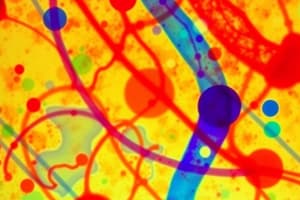Podcast
Questions and Answers
What is the main purpose of the polymerase chain reaction (PCR)?
What is the main purpose of the polymerase chain reaction (PCR)?
- To identify unknown DNA sequences
- To sequence the entire genome
- To remove unwanted DNA from a sample
- To replicate large amounts of a specific region of DNA (correct)
Who is credited with inventing the polymerase chain reaction (PCR)?
Who is credited with inventing the polymerase chain reaction (PCR)?
- Rosalind Franklin
- Kary Mullis (correct)
- Francis Crick
- James Watson
What is the role of primers in the polymerase chain reaction (PCR)?
What is the role of primers in the polymerase chain reaction (PCR)?
- They encode the entire genome
- They serve as markers for DNA identification
- They degrade unwanted DNA
- They flank the specific region to be amplified (correct)
What is the term used to describe the process of creating multiple copies of a specific DNA region in PCR?
What is the term used to describe the process of creating multiple copies of a specific DNA region in PCR?
What are the three main steps involved in each cycle of polymerase chain reaction (PCR)?
What are the three main steps involved in each cycle of polymerase chain reaction (PCR)?
What is the starting material of a PCR experiment always a complex mixture of DNA?
What is the starting material of a PCR experiment always a complex mixture of DNA?
The primers used in PCR are typically about 15 to 24 nucleotides in length?
The primers used in PCR are typically about 15 to 24 nucleotides in length?
The end result of PCR is the amplification of the region flanked by the primers, meaning many copies of the region have been made?
The end result of PCR is the amplification of the region flanked by the primers, meaning many copies of the region have been made?
Each cycle of PCR involves four steps: Denaturation, Primer Annealing, Primer Extension, and Termination?
Each cycle of PCR involves four steps: Denaturation, Primer Annealing, Primer Extension, and Termination?
The DNA region to be amplified in PCR can be chosen from any DNA molecule as long as the sequences at the borders of the region are known?
The DNA region to be amplified in PCR can be chosen from any DNA molecule as long as the sequences at the borders of the region are known?
Polymerase chain reaction (PCR) was invented by Kary Mullis in 1985 and he was awarded the Nobel prize in chemistry ten years later.
Polymerase chain reaction (PCR) was invented by Kary Mullis in 1985 and he was awarded the Nobel prize in chemistry ten years later.
The starting material of a PCR experiment can be a simple mixture of DNA.
The starting material of a PCR experiment can be a simple mixture of DNA.
The DNA region to be amplified in PCR can be chosen from any DNA molecule, regardless of whether the sequences at the borders of the region are known.
The DNA region to be amplified in PCR can be chosen from any DNA molecule, regardless of whether the sequences at the borders of the region are known.
Each cycle of PCR involves four steps: Denaturation, Primer Annealing, Primer Extension, and Termination.
Each cycle of PCR involves four steps: Denaturation, Primer Annealing, Primer Extension, and Termination.
The primers used in PCR are typically about 15 to 24 nucleotides in length.
The primers used in PCR are typically about 15 to 24 nucleotides in length.
Flashcards are hidden until you start studying
Study Notes
Main Purpose of PCR
- Amplifies specific DNA regions, creating multiple copies for analysis and research.
Inventor of PCR
- Kary Mullis invented the polymerase chain reaction (PCR) in 1985.
- Awarded the Nobel Prize in Chemistry in 1993 for this groundbreaking invention.
Role of Primers in PCR
- Primers are short sequences of nucleotides, typically 15 to 24 nucleotides long.
- They bind to specific regions of the DNA, initiating the replication process.
Process of Copying DNA in PCR
- The process of generating multiple copies of a specific DNA region is called amplification.
Main Steps in PCR Cycles
- Each cycle of PCR consists of three main steps:
- Denaturation: Separates the DNA strands by heating.
- Primer Annealing: Primers bind to the complementary DNA sequences.
- Primer Extension: DNA polymerase extends the primers, creating new DNA strands.
Starting Material for PCR
- The starting material can be a simple mixture of DNA, not necessarily complex.
Amplification Capabilities
- Any DNA molecule can be used for amplification, provided that the border sequences are known.
Cycle Components in PCR
- Each complete cycle involves four key steps: Denaturation, Primer Annealing, Primer Extension, and Termination to ensure successful amplification.
Summary of PCR Outcomes
- The end result is significant amplification of the target DNA region flanked by the primers, generating numerous copies.
Studying That Suits You
Use AI to generate personalized quizzes and flashcards to suit your learning preferences.




